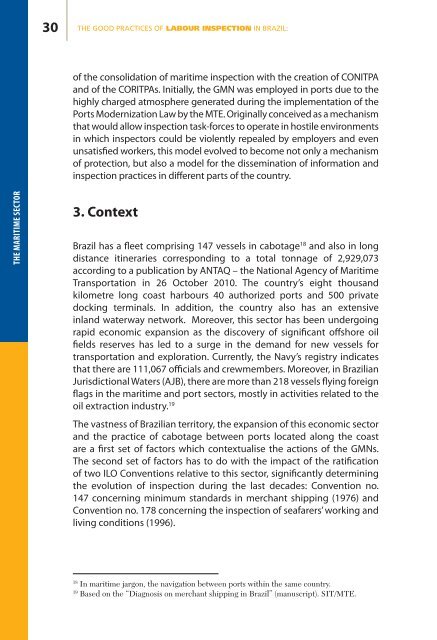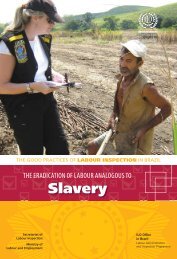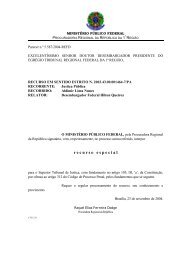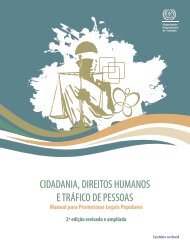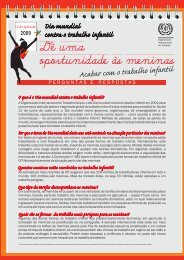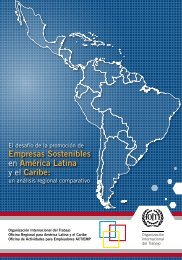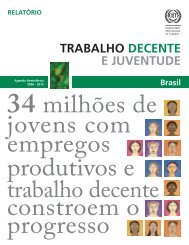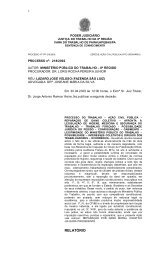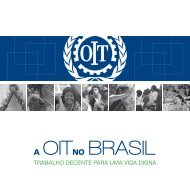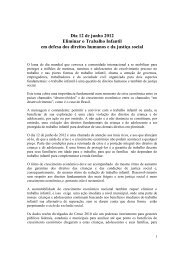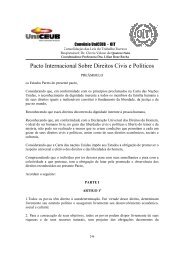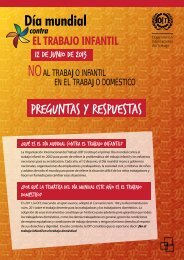30THE GOOD PRACTICES OF LABOUR INSPECTION IN BRAZIL:of the consolidation of maritime inspection with the creation of CONITPAand of the CORITPAs. Initially, the GMN was employed in ports due to thehighly charged atmosphere generated during the implementation of thePorts Modernization Law by the MTE. Originally conceived as a mechanismthat would allow inspection task-forces to operate in hostile environmentsin which inspectors could be violently repealed by employers and evenunsatisfied workers, this model evolved to become not only a mechanismof protection, but also a model for the dissemination of information andinspection practices in different parts of the country.THE MARITIME SECTOR3. ContextBrazil has a fleet comprising 147 vessels in cabotage 18 and also in longdistance itineraries corresponding to a total tonnage of 2,929,073according to a publication by ANTAQ – the National Agency of <strong>Maritime</strong>Transportation in 26 October 2010. <strong>The</strong> country’s eight thousandkilometre long coast harbours 40 authorized ports and 500 privatedocking terminals. In addition, the country also has an extensiveinland waterway network. Moreover, this sector has been undergoingrapid economic expansion as the discovery of significant offshore oilfields reserves has led to a surge in the demand for new vessels fortransportation and exploration. Currently, the Navy’s registry indicatesthat there are 111,067 officials and crewmembers. Moreover, in BrazilianJurisdictional Waters (AJB), there are more than 218 vessels flying foreignflags in the maritime and port sectors, mostly in activities related to theoil extraction industry. 19<strong>The</strong> vastness of Brazilian territory, the expansion of this economic sectorand the practice of cabotage between ports located along the coastare a first set of factors which contextualise the actions of the GMNs.<strong>The</strong> second set of factors has to do with the impact of the ratificationof two ILO Conventions relative to this sector, significantly determiningthe evolution of inspection during the last decades: Convention no.147 concerning minimum standards in merchant shipping (1976) andConvention no. 178 concerning the inspection of seafarers’ working andliving conditions (1996).18In maritime jargon, the navigation between ports within the same country.19Based on the “Diagnosis on merchant shipping in Brazil” (manuscript). SIT/MTE.
THE GOOD PRACTICES OF LABOUR INSPECTION IN BRAZIL: 31Box 3: Women in Merchant ShippingUntil the nineteenth century, the presence of women on board ships wasconsidered a bad omen and the low number of women employed in themerchant shipping sector during the twentieth century perhaps suggests thatthis superstition evolved into a form of gender exclusion. This situation hasbeen changing rapidly. In 2002, there were only 15 women registered as crewmembers of merchant vessels. This number has increased to approximately 3,300women, meaning that today approximately 3% of the total merchant shippingworkforce is female. This number tends to continue increasing since 30-40% ofthose enrolled in training courses for merchant shipping officers are women.Aware of this tendency, Brazilian legislation and inspection have taken specificactions in order to adapt to the presence of women in the merchant shippingsector, such as establishing new requirements for separate and privateaccommodations and ensuring specific women’s rights. In this sense, in October2010, a group – comprised of representatives from the Presidency’s Secretariat ofPolicies for Women, the National Council of Women’s Rights, the National Unionof Merchant Shipping Officials, the International Transport Workers’ Federation(ITF) and from employers’ associations – was created in order to discuss and draftproposals for the protection and expansion of women’s rights in the sector.THE MARITIME SECTORSource: SINDMAR -- http://www.sindmar.org.br/By ratifying Convention no. 147 in 1991, Brazil made several commitmentsrelative to the creation of working, social security, and safety and health normsand to the investigation of complaints concerning working conditions onboard national and foreign vessels, and, in the case, of the latter, the notificationof measures taken is sent to the ILO and to the diplomatic representation ofthe country of the ship’s registry. <strong>The</strong> convention’s Annex also presents severalspecific recommendations to be followed by national legislation.With the extinction of the DTMs in 1989, there was an institutional voidwhere the maritime and ports labour inspection was not undertaken.This situation ended in 1996 , with the creation of an inspection unit,the FITMARP, in Rio de Janeiro, which resumed inspection activities ofmerchant shipping vessels, both national and foreign, based on ILOConvention no. 147, its annexes and the ILO publication “Inspection ofLabour Conditions on Board Ship: Guideline for Procedures.”In 1999, the inspection of merchant shipping vessels advanced anadditional step with the creation of a specialised inspection structure(known today as the CONITPA and CORITPAs) and the approval ofimportant specific norms stipulating conditions and standards inaccordance with those specified by ILO Convention no. 147 (1976). In


